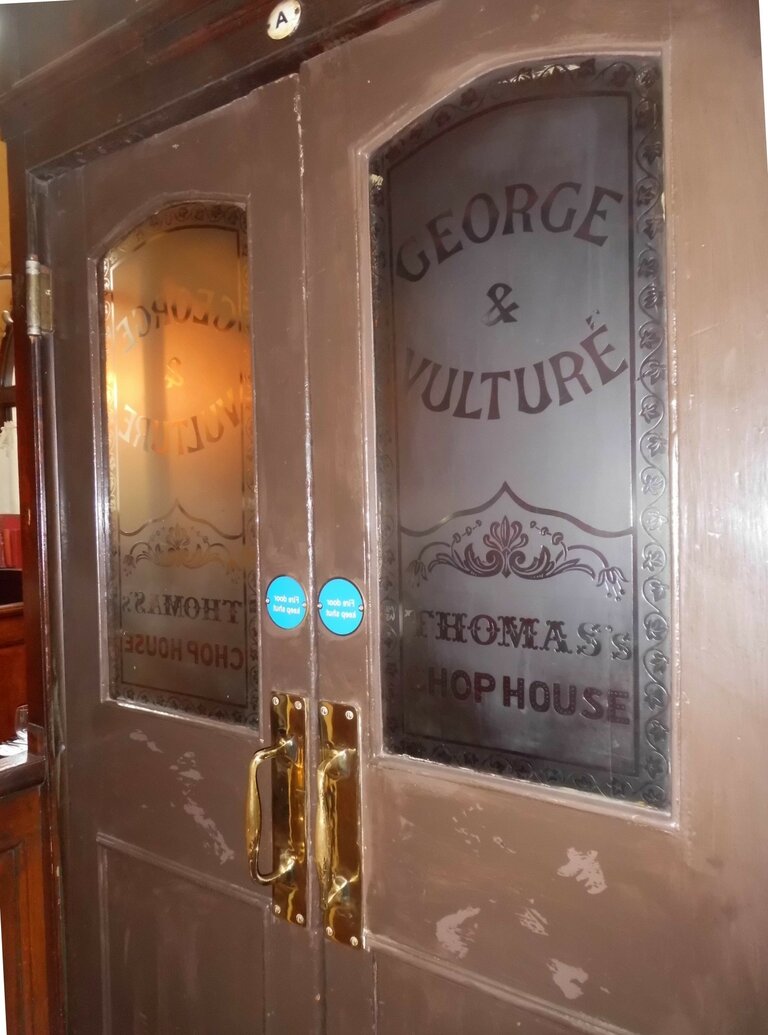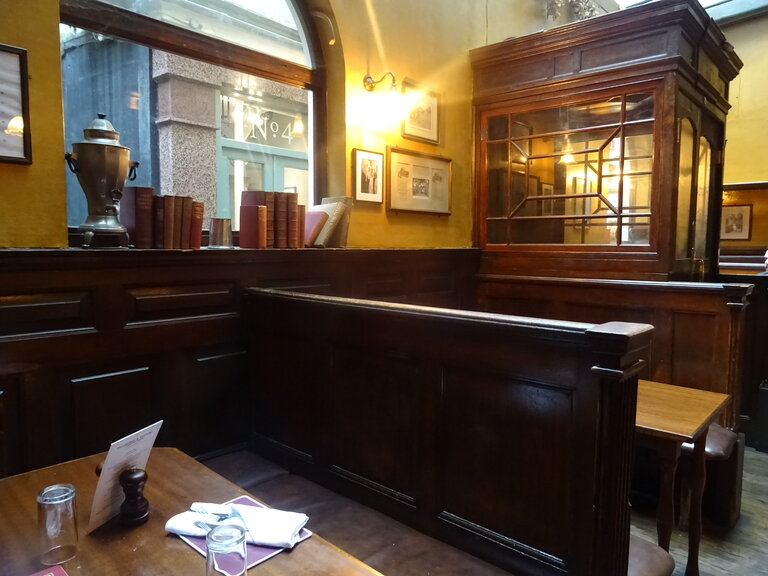George & Vulture
3 Castle CourtBank
London
EC3V 9DL
This pub is not only a grade II listed building, it is also a Two Star pub on the Campaign for Real Ale’s (CAMRA) National Inventory with an interior of very special national historic interest, and the description is as follows: "A revered Grade II listed 18th century chop house in the heart of the city retaining many 18th and 19th century features. For many years this establishment fell outside CAMRA’s definition of a pub: it sold no draught beer and customers were required to have a meal. Now it’s back on the map, serving Samuel Smith’s keg beers, with non-diners permitted so long as seating is available. Built in the early 18th century, the George and Vulture occupies one of those deliciously hidden locations in the City’s alleyways, and its unassuming entrance is very easy to overlook. The frontages on the east and north sides date from the 19th century. Inside is a glorious mixture of 18th and 19th century fittings. At the south east entrance, etched glass in a set of double doors bears the inscription “Thomas’s Chop House”. Inside these is a small foyer area with an old wooden counter, probably 19th century, and presumably where diners would once have left their hats and coats. More doors lead into the main ground floor room which contains a small servery enclosed in wood and glass. It gives every impression that it once may have been a publican’s office. On one wall is an ancient and dramatic fireplace – possibly 18th century - with a decorative tiled surround. Beside a window on the 19th century stairs to the first floor is an old bell-push, but its exact purpose must remain a mystery for now. Stairs to the second and third floors are survivors from the 18th century and lead to three comfortable rooms all with decor and furniture - such as settles forming cosy booths - sympathetically chosen by the brewery to reflect the pub’s considerable age. One booth, with a curving settle around it, is especially characterful. The two “Dickens Rooms” occupy the top floor, so called because the writer actually lived here for some time, and mentioned the pub many times in his 1837 novel The Pickwick Papers. At some time in the past, the pub expanded into a small shop next door which now forms a cosy snug room reached through an arched doorway that has been inserted. This section still has an original 19th century shop-front."
The listing description is as follows "former public house, coffee-house and chop-house, now a restaurant. Early C18, refronted early C19 and later alterations; originally with eastern wing in George Yard, now demolished. Stucco.
Four-storeys and cellar. Five windows. Channelled stucco, ground floor extended forward with glazed penthouse roof. Central round-arched entrance with fluted pilastered architrave and keystone, fanlight and panelled doors. To each side a round-arched architraved window with keystone. Upper floors, recessed sashes; second floor with Art Nouveau stained glass to lower sections. Portland stone cornice at third floor level. Parapet. Left hand return forms wall of passage to George Yard with segmental arched entrance having Doric half columns. Two parish boundary plaques inscribed "SEK 1814" and "41/S,MC/1830". Narrow right angled elevation to George Yard, mid C19 stucco with dressings and narrow passage through ground floor Bengal Court.
Interior has early C19 cast iron Corinthian columns supporting first floor where ground floor extends forward. Ground floor has oak panelled dado and seats and carved oak overmantle with scrolled pediment, inset clock and painting of mail coach; white veined brown marble fire surround. All late C19 in C18 style. Dogleg stair having landing at first floor level. Second and third floor flights early C18; closed string with moulded cornice, column newels, turned balusters and moulded handrail with flat caps to newels. Moulded dado rail and skirting follows line of stairs. Flight to first floor probably later, closed string, turned balusters, moulded handrail, bottom newel a short column on foliar carved base. Inserted in landing string over first flight, a small carved C18 wooden round-arched aedicule with floral enrichment to head and ribbon and floral drops to moulded wings. Landing has moulded cornice with frieze of moulded plaster festoons. Upper floors with C18 style fireplaces, probably C19, first floor back room fireplace with late C19 blue and white Aesop Fable minton tiles. Many rooms with box cornices.
No 3 - late C19 house with shopfront to right and new part of restaurant. Stucco. Two storeys and attic, single window. Ground floor with good late C19 shopfront with pilasters, panelled stallboard, small panes and foliated fascia brackets. Associated with many literary figures including Charles Dickens."
The WhatPub link is here: WhatPub/George & Vulture
The Pub Heritage Group link is here: George & Vulture
The George & Vulture is yet to feature on a LPG pub tour.





